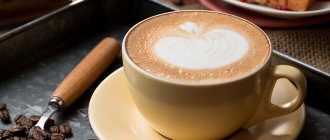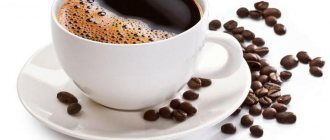Which coffee drinks have milk added to them?
As statistics show, the most popular recipes for coffee with the addition of cream or milk are: a drink with thick foam - cappuccino, aromatic coffee latte. Other names for coffee with milk: invigorating macchiato and espresso with milk, coffee with Irish whiskey, tart ristretto, brewed in a coffee machine, with the addition of whipped foam.
People who love the coffee aroma, but do not drink the drink hot, prefer tasty and high-calorie cocktails with the addition of syrups, ice cream and instant coffee. Serve the cocktail with ice or coffee beans for decoration.
A person who does not consider himself a coffee connoisseur may think that all the recipes listed are similar in taste. This is a wrong opinion. The differences between different cooking methods are significant. Therefore, their taste also varies greatly.
Cappuccino
The golden mean in terms of the milk/coffee ratio. Moreover, the proportions are not fixed by reinforced concrete regulations and may differ to a certain extent, but will always strive for a simple formula: 1:1:1. That is, if we take a standard 36 g espresso, then we will need to add 36 g of hot milk and 36 g of milk foam to it. All.
Now, giving in to consumer taste, coffee shops are moving away from these standards and adding more milk, making the drink softer and sweeter. An acceptable and common recipe is: add one serving of espresso to a 150-180 ml cup, top with hot milk, almost to the brim, leaving 1 cm, which is filled with milk foam. The funny thing is that almost the same proportions are typical for a classic latte. But in a coffee shop that serves you a new style cappuccino, you will also get a new style latte—with even more milk.
Mandatory principles for making cappuccino:
The base is espresso made from freshly ground coffee.
The milk is poured into the espresso, not the other way around.
Top with whipped milk foam.
© flickr.com
How milk changes the taste of coffee
According to true connoisseurs of classic ground coffee, the subtle milky flavor is added to the recipe for a reason. This is done for the following reasons:
- coffee becomes softer in taste, the bitter notes of coffee beans are no longer felt;
- espresso with low-fat milk significantly reduces the content of natural caffeine;
- coffee with milk is a high-calorie drink that can not only charge the body with positive energy, but also give strength for the whole day;
- For people who cannot drink drinks that are too hot, milk helps cool them down to a pleasant temperature;
- By drinking a cup of espresso with the addition of milk, a person gets the opportunity to make his taste sensations more vibrant and varied.
Every housewife has her own recipes for the family's favorite drink. It's not difficult to prepare. The main thing is to maintain the required proportions of the components. Each family may have its own proportions; they are selected according to the personal preferences of family members.
If Americano is used to prepare the treat, the taste will not be as rich. Americano is espresso coffee diluted with hot water in a 1:1 ratio.
When preparing coffee espresso with cream at home, you can use a little trick that will help make the drink more tasty. For this purpose, preheated milk is used as an additive. If you use this tip, you may be pleasantly surprised at how the color of the product changes. The coffee will take on a beautiful caramel color.
Coffee with milk for diets and weight correction
Any diet is a necessary measure. People adhere to a special diet either for any illness or to lose weight.
There are a great many diets in which the consumption of fermented milk products is recommended. But with fresh milk everything is more complicated.
The purpose of the diet is to “unload” the body, allowing it not to waste energy on digesting heavy food, but to use it to normalize metabolic processes and get rid of toxins. Fresh milk contributes to constipation, that is, it aggravates the very slagging that the diet was invented to eliminate.
A separate type of diet is for weight loss. There are a great many of them, and there are also those in which it is allowed and even recommended to drink coffee. The drink really promotes weight loss: caffeine speeds up metabolism, promotes the “burning” of fat reserves, the substance is effective in the fight against cellulite, and the chlorogenic acid contained in coffee is a powerful antioxidant.
But if your diet requires you to drink coffee, you always mean black coffee. Fresh milk weakens the effect of caffeine and neutralizes chlorogenic acid. That is, because of one coffee and milkshake, all efforts to lose weight can go down the drain. There is no point in experiencing the inconvenience of restricting yourself in food, and at the same time negating all the benefits of the diet by drinking milk.
Milk itself is not that high in calories: depending on the fat content, 40–70 kcal. For those who are healthy, but are watching their weight by counting the daily number of calories, because of the difference of 10–20 kcal, you should not give up coffee with delicious whole milk and give preference to low-fat milk. In any case, after a coffee-milkshake you will have to reduce your diet or do without dinner altogether.
Coffee: types with milk
In order to understand how the types of coffee drinks differ from each other, you need to get to know each of them in detail.
Fragrant cappuccino with melt-in-your-mouth foam
The main ingredients of the drink are espresso, milk and thick foam. To achieve the desired foam thickness, you need to use heated milk. The milk foam is carefully poured into the contents of the cup. When combined with espresso, it forms unusual creamy stains. The taste of espresso with warm milk is different from the usual coffee with milk. He becomes more gentle and pleasant.
What proportions should be observed: each component is taken in equal parts. According to statistics, this recipe is one of the most popular in the world. Different coffee shops offer different amounts of the drink served.
The volume can be from 150-200 ml. An important condition that must be observed in any establishment is the elevation of the whipped foam above the edge of the container. Due to the special density of the foam consistency, it can maintain a spherical shape for some time and not spill.
Many cappuccino lovers prefer to drink it by sprinkling the thick foam with aromatic cinnamon or grated chocolate chips. Do not stir the foam when drinking. Each sip of coffee passes through a delicate consistency. True connoisseurs of cappuccino drink it without added sugar. This allows you to get more pleasure from its unusual taste.
Classic milk coffee recipe
To brew coffee with milk, it is better to use a teapot with a wide neck, and its volume should be one and a half to two times larger than the volume of the cup: both coffee and milk like to “run away” during cooking, and the foam will rise quickly - and very high.
Pour milk into the Turk, add spices and a little sugar if desired. Milk itself will give the finished drink a slightly sweet taste, and this must be taken into account by reducing your usual dose of sugar by about one and a half times.
Warm up the milk a little and add ground coffee to the pot. There is no need to stir the drink at this stage, otherwise coffee particles will settle to the bottom of the pot and the drink will end up less rich and less aromatic.
Over low heat, bring the coffee to the top, remove the Turk from the heat and stir the drink. Let it “rest” for a minute and a half, then put it back on very low heat and wait for the “foam” again. Coffee with milk is ready.
Delicate milky latte taste
To make a delicious drink according to the classic recipe, you need to use a mixture of espresso and warm milk to prepare it. This recipe also calls for foam. But the proportions of foam are different compared to cappuccino. For a latte you will need 1/5 of a strong coffee base, the same part of whipped foam, the remaining part (3/5) is taken by warm milk. It is possible to add 30 ml of cold water per serving.
Many coffee drinkers call this brewing process a cocktail because of the small amount of strong ground coffee. This recipe requires the addition of sugar and other sweet additives. Latte with cream is served in large glass glasses with a volume of at least 400 ml.
Making a creamy latte requires creativity. The taste of the drink changes when berry and fruit syrups are added to it. Drawing unusual pictures on surfaces is gaining popularity all over the world. This hobby was given a special name: latte art. One way to make a latte is called latte macchiato. The recipe is made in the same proportions as the classic drink. A special feature of the preparation is the use of different layers of the contents of the glass, which do not mix with each other. Toppings and sugar cubes are added during the creation of the drink, and not after it is served.
Invigorating macchiato
One of the options for coffee with milk is macchiato. It is made from standard ingredients: black coffee and thick whipped foam. The foam is spread onto the coffee drink using a special spoon. Due to the lack of mixing of ingredients, the color of natural coffee does not change. Foam serves as an unusual decoration. Tender milk foam that melts in the mouth is used to soften the strength and reduce the invigorating effect.
The proportions for preparing the recipe are as follows: ¾ part coffee and the remaining part is taken by strong foam from whipped milk. In order to enjoy the taste of the drink, it is not recommended to add sugar to it.
The ingredients of the drink should not be mixed; they should be arranged in layers. Unlike cappuccino, each layer is located separately. Snow-white foam can be diluted with coffee specks. And this is no coincidence: the name of the drink is translated as spotted.
Mocha with chocolate notes
The name mocha comes from a special variety of coffee beans, which is one of the varieties of the familiar Arabica. Mocha is prepared with the addition of warm milk of varying fat content and grated chocolate chips.
Quick coffee with milk
This drink is slightly inferior to the classic one in terms of taste - after all, the slower the extraction occurs, the more intense the finished coffee turns out. But on the other hand, you don’t need to watch the pot for a long time and the risk of “missing” the coffee by boiling it is much lower.
Pour milk into the Turk, bring it to a boil and remove from heat. Add sugar and spices, add coffee and mix well. Place the Turk on low heat and bring the drink to the top, let it stand for a couple of minutes, then tap the bottom of the Turk several times on the edge of the stove or cutting board so that the coffee grounds settle to the bottom. You can pour it into cups!
Who is advised to consume the drink?
The delicate drink not only contains a pleasant creamy taste, but is also an alternative to grain coffee. Who may need the recipes listed above:
- People wishing to reduce their daily caffeine intake. This substance decreases when milk foam is added to the drink. Its effect on the body will be more gentle.
- For some chronic diseases, it is strictly not recommended to drink strong coffee. A drink with milk will be an alternative solution.
- The drink diluted with warm milk can be drunk in childhood. Caffeine-containing products are contraindicated for children. Milk will reduce the effect of caffeine on the child's body.
If you are following a low-calorie diet, you should add 1% milk to your coffee drink. Girls who are watching their figure are not recommended to drink high-calorie macchiatos and lattes. Due to the large amount of milk, each serving of the treat contains at least 100 kcal.
WHAT ALL COFFEE LOVERS SHOULD KNOW: IF YOU ADD MILK TO ESPRESSO
It is difficult to imagine the modern coffee world without espresso. Although not every lover of a drink with milk knows about its importance. Many people believe that this applies only to fans of strong black coffee. But this is a gentle latte, a soft cappuccino or flat white for a pleasant conversation, and a fragrant macchiato in the morning.
The basis of such drinks that are familiar to us is espresso. Virtually the entire assortment in most coffee shops in European, American and post-Soviet countries relies on it. Let's take a closer look at those options that are prepared with milk. Let's find out what the fundamental difference is between them and which one to choose according to your mood.
The obvious option is macchiato . Let's start with it. In Italian, macchiato means stained. In this case, the speck is a spoonful of whipped milk against the background of nut cream, that is, foam. True, sometimes instead of 10-15 ml of speck, milk is added almost to the brim of the cup. It turns out, so to speak, a kind of variation on the theme of cappuccino. It’s also tasty and looks beautiful, but the drink is not the same.
But when they spread not milk, but whipped cream (sometimes sprinkled with grated chocolate), it turns out to be con panna (Italian with cream) or Viennese style . Before the widespread use of coffee machines, the coffee base of the Viennese drink did not play a special role. But starting from the second half of the twentieth century, it is rarely made with espresso.
By the way. It was thanks to Viennese coffee that the tradition of serving a glass of water also appeared. It all started at the end of the 19th century, of course, in coffee houses in Austria. The noble ladies who ordered this drink had a serious problem - what to do with a dirty spoon?
Putting it in cream on the edge of a saucer is blatantly inelegant, and the option of licking it first is generally beyond the bounds of etiquette. A glass of water intended for rinsing the spoon helped correct the situation.
Now let's move on to drinks that many do not associate with espresso. So, cappuccino . Its appearance is associated with the Capuchin monks. The monks generally gave us a lot of interesting things, invented personally or learned in distant unexplored countries. They showed their creativity with all sorts of goodies.
So in distant Japan, Jesuit missionaries began to fry shrimp, replacing the meat prohibited during Lent. This led to the emergence of such a Japanese dish as tempura. They also introduced the world to Paraguayan matte tea, at first even called the drink of the Jesuits.
But thanks to the Benedictines, we enjoy liqueurs, sparkling wine and Parmesan cheese. The situation with cheeses in general is such that there is hardly any known variety that is not of monastery origin. It was the monks who came up with the idea of smoking cheese, salting it, seasoning it with spices and noble mold.
However, let's return to the topic of our story. The monks loved to eat coffee with milk. Either they liked drinking this drink more, or they were masking the “devilish” black coffee, which was not encouraged by their superiors. Like many others who poured milk into coffee, they noticed the formation of a layer of pleasant-tasting foam. And they did not ignore this fact.
The story, retold many times over the centuries, has become a legend. The foam was obtained using various mechanical devices for whipping coffee with milk, and later hot milk. Then, at the end of the 19th century, a technological breakthrough took place. There were also inventors among the monks. One of them, Padre Carlo, came up with a way to froth milk with hot steam.
The idea was put into practice by a self-taught mechanic, Giuseppe, who lived near one of the monasteries north of Rome. His apparatus had two sections. In one of them, the water poured in was turned into steam by heating, which flowed through a tube into the second, where the milk actually frothed. Modern coffee machines with steam cappuccino makers use the same principle.
Rumors, and eventually the drink itself, first spread throughout Italy. Its milder taste has made it popular among coffee lovers in other countries. The name cappuccino comes from cappuccio - hood in Italian. According to the most popular and plausible version, it reflects the similarity of the pointed “cap” of milk foam with the hood of the Capuchin monks.
A classic cappuccino is usually described as a drink of three equal parts. That is, the ratio of espresso, heated milk and “hood” of foam should be 1:1:1. However, this rule is now outdated and has been replaced by the 1 to 4 option. Where one part is coffee, and four are milk and a layer of non-porous, thick, velvety foam approximately 1 cm thick. A standard portion is served in a special cappuccino cup with a capacity of 150-180 ml. Double is prepared on the basis of two espressos in a large cup - from 280 ml.
We also recommend: A CUP OF COFFEE – DEFEATIVE or HEALTHY?
Cappuccino is not drunk through a straw! Yes, it’s more convenient, especially when on the go. But the whole point of this drink is that when you tilt the cup or glass, the espresso mixes with the foam, becoming soft, tender and vanilla-sweet, and only then gets into your mouth.
And through the straw, the bitterness of espresso first hits the taste buds, and then comes the foam. In this case, you cannot do without sugar. But a properly prepared cappuccino: not scalding hot (up to 65 ° C) and with good milk, does not require sugar. The sweetness comes from the lactose contained in milk.
The cappuccino also has its own spoon. It is difficult to stir the sugar with a small coffee pot - it does not reach the bottom of the cup. Therefore, cappuccino is larger than coffee or tea, but smaller than a dessert spoon. Moreover, it can be not only made of stainless steel, but also wood, cupronickel, ceramic, glass, ivory, etc. However, in ordinary coffee shops they don’t bother too much and just serve a teaspoon.
In cappuccino, the combination of coffee and milk is harmonious. There is a balance between them without one predominant over the other. Those who prefer a milkier taste will like caffe latte or just latte .
It is prepared using one shot of espresso. In this case, unlike cappuccino, the milk hardly froths. The liquid is covered with foam about half a centimeter thick. The drink is served in a container with a volume of 210-240 ml. The proportions of coffee and milk in it are 1 to 6.
Caffe latte translates as coffee with milk. We usually shorten it to a latte. But in Italy you can well pay for such freedom. If you order just a latte (that is, milk), they will serve you a glass of it.
In Italian, latte is pronounced with the accent on the first vowel. So why do coffee gourmets argue about the correctness of the accent? The fact is that in the English-speaking powers the sound was transformed to suit the characteristics of their language, placing emphasis on the second vowel. And from them this option spread to other countries. That is, in fact, you can pronounce it in any way.
, latte is popular . This situation is similar to the case of Americano and long black, when the sequence of components during preparation affects the result. In the case of a latte macchiato, coffee is added to already poured and partially frothed milk, leaving a brown speck on the snow-white foam. The result is a beautiful layered drink, which is served in a tall clear glass goblet or tumbler.
For lovers of a more clearly visible coffee taste, there is a flat white. It originally appeared at the end of the last century in coffee shops either in Australia or New Zealand. In general, somewhere there. Some customers didn't like the pile of foam on their cappuccino. They believed that they were overpaying for air. Therefore, they demanded flat foam and a more coffee-like drink.
A flat white is prepared in a standard cappuccino portion based on not one, but two espressos. The ratio of coffee and milk is 1 to 3. The milk is whipped less than for cappuccino. It should be velvety, without bubbles and foam, which lies only on top in a thin (approximately 0.25 cm) even layer. It is usually served in a glass or cup with latte art.
Since this topic is truly vast, you probably have something to add, clarify or express your opinion. Don’t be shy and don’t delay – write in the comments to other readers.
Share information - don't leave your friends in the dark: Facebook
VK
Tumblr
StumbleUpon
Buffer
Recipe: Sweet coffee with milk. Calorie, chemical composition and nutritional value.
Nutritional value and chemical composition of “Sweet coffee with milk”.
The table shows the nutritional content (calories, proteins, fats, carbohydrates, vitamins and minerals) per 100 grams of edible portion.
| Nutrient | Quantity | Norm** | % of the norm in 100 g | % of the norm in 100 kcal | 100% normal |
| Calorie content | 37.6 kcal | 1684 kcal | 2.2% | 5.9% | 4479 g |
| Squirrels | 0.6 g | 76 g | 0.8% | 2.1% | 12667 g |
| Fats | 0.5 g | 56 g | 0.9% | 2.4% | 11200 g |
| Carbohydrates | 7.6 g | 219 g | 3.5% | 9.3% | 2882 g |
| Water | 90.8 g | 2273 g | 4% | 10.6% | 2503 g |
| Ash | 0.3985 g | ~ | |||
| Vitamins | |||||
| Vitamin A, RE | 1.9 mcg | 900 mcg | 0.2% | 0.5% | 47368 g |
| Retinol | 0.002 mg | ~ | |||
| Vitamin B1, thiamine | 0.014 mg | 1.5 mg | 0.9% | 2.4% | 10714 g |
| Vitamin B2, riboflavin | 0.081 mg | 1.8 mg | 4.5% | 12% | 2222 g |
| Vitamin B4, choline | 1.94 mg | 500 mg | 0.4% | 1.1% | 25773 g |
| Vitamin B5, pantothenic | 0.19 mg | 5 mg | 3.8% | 10.1% | 2632 g |
| Vitamin B6, pyridoxine | 0.001 mg | 2 mg | 0.1% | 0.3% | 200000 g |
| Vitamin B9, folates | 2.332 mcg | 400 mcg | 0.6% | 1.6% | 17153 g |
| Vitamin C, ascorbic acid | 0.11 mg | 90 mg | 0.1% | 0.3% | 81818 g |
| Vitamin E, alpha tocopherol, TE | 0.007 mg | 15 mg | 214286 g | ||
| gamma tocopherol | 0.0075 mg | ~ | |||
| Vitamin K, phylloquinone | 0.1 mcg | 120 mcg | 0.1% | 0.3% | 120000 g |
| Vitamin RR, NE | 0.2918 mg | 20 mg | 1.5% | 4% | 6854 g |
| Niacin | 0.019 mg | ~ | |||
| Macronutrients | |||||
| Potassium, K | 64.01 mg | 2500 mg | 2.6% | 6.9% | 3906 g |
| Calcium, Ca | 24.08 mg | 1000 mg | 2.4% | 6.4% | 4153 g |
| Magnesium, Mg | 4.85 mg | 400 mg | 1.2% | 3.2% | 8247 g |
| Sodium, Na | 10.89 mg | 1300 mg | 0.8% | 2.1% | 11938 g |
| Phosphorus, P | 19 mg | 800 mg | 2.4% | 6.4% | 4211 g |
| Chlorine, Cl | 18.66 mg | 2300 mg | 0.8% | 2.1% | 12326 g |
| Microelements | |||||
| Aluminium, Al | 9.3 mcg | ~ | |||
| Iron, Fe | 0.046 mg | 18 mg | 0.3% | 0.8% | 39130 g |
| Yod, I | 1.68 mcg | 150 mcg | 1.1% | 2.9% | 8929 g |
| Cobalt, Co | 0.168 mcg | 10 mcg | 1.7% | 4.5% | 5952 g |
| Manganese, Mn | 0.019 mg | 2 mg | 1% | 2.7% | 10526 g |
| Copper, Cu | 3.36 mcg | 1000 mcg | 0.3% | 0.8% | 29762 g |
| Molybdenum, Mo | 0.933 mcg | 70 mcg | 1.3% | 3.5% | 7503 g |
| Tin, Sn | 2.8 mcg | ~ | |||
| Selenium, Se | 0.187 mcg | 55 mcg | 0.3% | 0.8% | 29412 g |
| Strontium, Sr | 3.17 mcg | ~ | |||
| Fluorine, F | 71.42 mcg | 4000 mcg | 1.8% | 4.8% | 5601 g |
| Chromium, Cr | 0.37 mcg | 50 mcg | 0.7% | 1.9% | 13514 g |
| Zinc, Zn | 0.0896 mg | 12 mg | 0.7% | 1.9% | 13393 g |
| Digestible carbohydrates | |||||
| Mono- and disaccharides (sugars) | 7.6 g | ~ | |||
| Essential amino acids | |||||
| Arginine* | 0.0007 g | ~ | |||
| Valin | 0.0022 g | ~ | |||
| Histidine* | 0.0015 g | ~ | |||
| Isoleucine | 0.0015 g | ~ | |||
| Leucine | 0.0037 g | ~ | |||
| Lysine | 0.0007 g | ~ | |||
| Threonine | 0.0007 g | ~ | |||
| Phenylalanine | 0.0022 g | ~ | |||
| Nonessential amino acids | |||||
| Alanin | 0.0022 g | ~ | |||
| Aspartic acid | 0.0037 g | ~ | |||
| Glycine | 0.003 g | ~ | |||
| Glutamic acid | 0.0149 g | ~ | |||
| Proline | 0.003 g | ~ | |||
| Serin | 0.0007 g | ~ | |||
| Tyrosine | 0.0015 g | ~ | |||
| Cysteine | 0.0015 g | ~ | |||
| Sterols (sterols) | |||||
| Cholesterol | 1.31 mg | max 300 mg | |||
| Saturated fatty acids | |||||
| Saturated fatty acids | 0.3 g | max 18.7 g | |||
| 16:0 Palmitinaya | 0.0015 g | ~ | |||
| Monounsaturated fatty acids | 0.0112 g | min 16.8 g | 0.1% | 0.3% | |
| 18:1 cis | 0.0112 g | ~ | |||
| Polyunsaturated fatty acids | 0.0007 g | from 11.2 to 20.6 g | |||
| 18:2 Linolevaya | 0.0007 g | ~ | |||
| Other substances | |||||
| Caffeine | 29.8507 mg | ~ |
The energy value of sweet coffee with milk is 37.6 kcal.
Primary Source: Created in the application by the user. Read more.
** This table shows the average levels of vitamins and minerals for an adult. If you want to know the norms taking into account your gender, age and other factors, then use the “My Healthy Diet” application.











